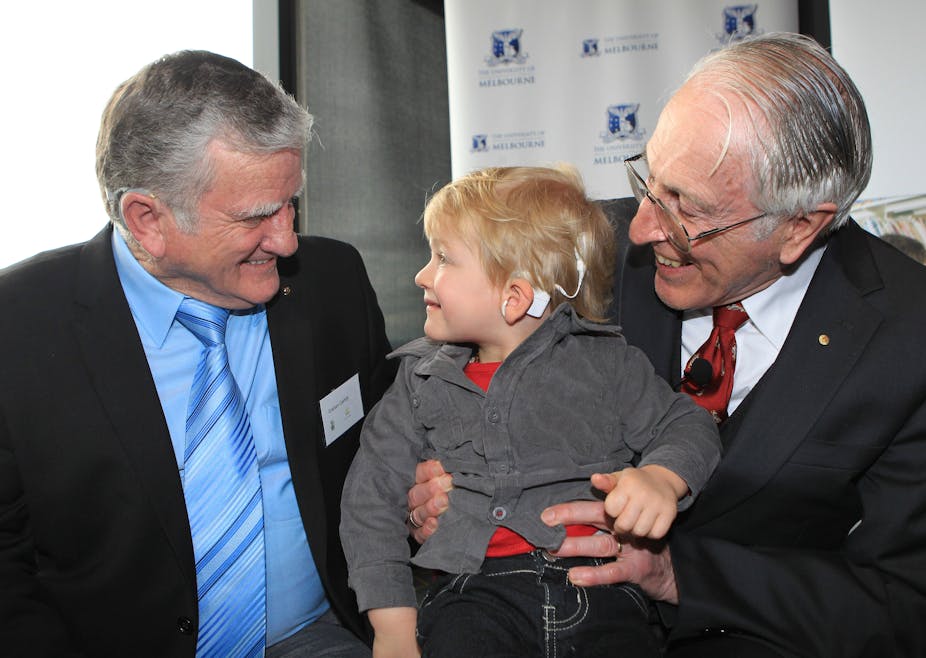The creator of the cochlear implant - a revolutionary device that enables people born or made deaf through disease or trauma to hear and recognise speech - has won a top international award in clinical medical research.
Graeme Clark, emeritus professor at the University of Melbourne, was presented with the prestigious Lasker DeBakey at a ceremony in New York on Friday. He shared the prize with Austrian Ingeborg Hochmair and American Blake S. Wilson, two researchers who played a prominent role in the development and efficacy of the prosthesis.
The Lasker DeBakey honours living persons who have made major contributions to medical science as well as those who have performed tremendous public service on behalf of medicine.
Stephen O’Leary, who holds the William Gibson chair of otolaryngology at the University of Melbourne, said the Lasker is very highly regarded in the medical community.
“It’s sometimes thought to be the US Nobel Prize and many prize winners have actually been awarded Nobel Prizes so I think that it is of similar standing in the medical community,” he said.
‘Interface between the world and human consciousness’
While most scientists in the 1970s believed it impossible to restore the numerous complexities of speech perception to a damaged auditory system, Clark and Hochmair challenged conventional resistance and independently designed a successful multiple-channel cochlear implant.
Two decades later, Blake Wilson pioneered software strategies that enhanced the device’s effectiveness. He developed a widely-used speech strategy, referred to as continuous interleaved sampling (CIS), which mimics the frequency mapping of a normal cochlea.

In his acceptance speech, Clark described the cochlear device, also known as the bionic ear, as “the first clinically successful interface between the world and human consciousness.”
He told those present at the ceremony that its discovery was the “first advance in helping severely-to-profoundly deaf children communicate since sign language of the deaf 250 years ago.”
“When I started my research journey there was much scepticism,” Dr Clark said in New York. “It had been said that direct stimulation of the auditory nerve fibres with resultant perception of speech is not feasible.”
Driven by his father’s hearing disability, Clark set out to study auditory neurophysiology in 1967. While numerous hearing aids were already in existence at the time, the sound perceived through them was severely distorted.
“You could turn up hearing aids loud enough so that most people could hear something but they just couldn’t make sense of what they were hearing because the sound was greatly distorted. It’s a bit like having a tiny speaker and putting a Marshall amplifier behind it,” explained O’Leary who completed his doctoral studies under Graeme Clark’s mentorship in the 1980s.
“Graeme’s fundamental research confirmed that for there to be enough fidelity in the signals going from the ear to the brain, you needed to have a series of different parts of that, that are being stimulated at the same time.”
Reactivating a sense
Appointed as the foundation professor of otolaryngology at the University of Melbourne in 1970, Graeme Clark led his team to develop the first prototype of the bionic ear.
The surgically implanted prosthesis works through individual electrodes exciting a single subset of auditory nerve fibres that are sensitive to similar sound frequencies.
The first experimental surgery was performed successfully in 1978 on patient Rod Saunders. As of mid-2013, 320,000 people worldwide are carrying the implant.
Equating the medical sophistication of the bionic ear to the advances required to achieve the moon landing, O'Leary said the cochlear implant was “by far the most profound of the prosthetics out there”.
“Graeme wasn’t a cowboy. He wasn’t someone who just got in there and struck it lucky. He actually did the hard work. This was actually brave and provided the restoration of a sense to a human being, it’s an extraordinary thing.”
Since the Lasker Foundation began administering the awards in 1946, 78 Lasker laureates have gone on to win a Nobel prize.

